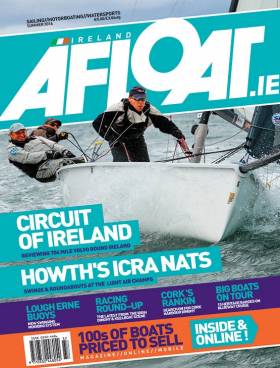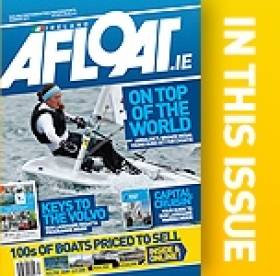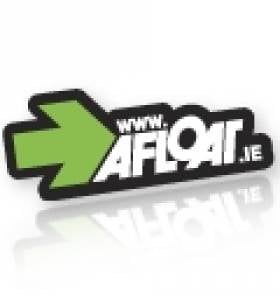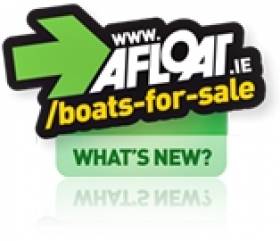Displaying items by tag: Afloat magazine
In a survey of competitors at the 2019 Volvo Dun Laoghaire Regatta on Dublin Bay, 60% of respondents said the Irish boating portal 'Afloat.ie' was their 'go-to' website for Irish sailing & boating news.
Nearly 200 sailors were polled from the 500-boat international regatta fleet that attracts sailors from across Ireland and the UK.
In reply to the single question: 'What's your go-to resource for Irish sailing and boating news?', 117 or 60.31% responded 'Afloat'.
The popular UK magazine site 'Yachts and Yachting' accounted for 30 or 15.46%.
Club or association websites totalled 26 or 13.4%.
Last December, Afloat reported statistics showing unique visitors to the site were heading for 1.3 million per annum.
Afloat’s popular online format has a strong returning readership, with half of daily visits being repeat readers, and with strong social media engagement.
Based on-site analytics, 70% of Afloat web traffic is from Ireland, with a good geographic spread across the Irish Sea and into the west coast of Britain. It is a result that tallies with the weekend survey at Dun Laoghaire Regatta.
Read more on Afloat here.
Afloat Magazine Summer Edition Out Now!
Get the latest edition of Afloat magazine is in your newsagents now. The 48–page edition carries news from all coasts and is on sale at €5. Contents include:
Irish Sailing Association News Sailing's busy season and 'bright future' is outlined by President David Lovegrove
News New Irish Cruising Club directions, Legal challenge against Carlingford Ferry, Scottish economy benefits from marine tourism billions, Burglary at Lahinch surfing school, €1m repair works to piers in Dun Laoghaire Harbour, Irish
National Sailing School expands fleet at Dun Laoghaire Harbour, Western Marine of Dalkey relocates after 48 years at Bulloch Harbour, Sligo Bay RNLI’s new Inshore Atlantic 85 Lifeboat named and lots more
Dubarry Nautical Crossword A nautical crossword with a great boating prize of Dubarry deck shoes
Inland Waters News A new buoy system on Lough Erne
Racing Round up Winter wins in the Caribbean for Fogerty and O'Coineen, team racing heads west plus all the dinghy racing news for the summer season ahead
Volvo Cork Week Home victories at Crosshaven
ICRA Nationals Swings and Roundabouts in Howth
Volvo Round Ireland A race of four coasts, four fleets and four seasons
Brokerage Services Boats for sale and marine services
Soundings Royal Cork's eternal youth
Afloat Magazine Spring Edition Out Now!
Get the latest edition of Afloat magazine is in your newsagents now. The 48–page edition carries news from all coasts and is on sale at €5.
Contents include: Irish Sailing Association News on an upgraded Try sailing initiative plus a new sailing passport, how Donegal is putting itself on the cruising map; will new laws hinder canals?; 50 years of Fireballs; A nautical crossword with a great boating prize of Dubarry deck shoes; Liam Shanahan is Afloat's 2015 Sailor of the Year plus lots lots more.
Sailing Towards Better Communications in the Digital World
The Afloat.ie website, which is ranked by Google as Ireland’s leading source for the provision of a broad range of recreational and commercial maritime information, news and comment, has been completely updated in recent weeks. Yet though it has acquired a fresh, fast-moving look, and now provides a new and unrivalled multi-platform service, the change has been effected without any interruption to service. That said, our alert and more tech-savvy readers have been welcoming each addition to our service as it comes online. The new-style Afloat.ie is both a ground-breaking development for maritime communications and news exchange and analysis in Ireland, and yet it is also a healthy continuation of an integral part of our maritime life which stretches back more than fifty years. W M Nixon takes up the tale, and looks forward to where this remarkable story might lead us all.
In the early 1960s the Irish Dinghy Racing Association (founded 1946) was in the process of being re-born as the Irish Yachting Association. A competitive three-boat Irish campaign had been mounted for the 1960 Rome Olympics with the sailing events in Naples, and the confidence gained from this project gave the nascent national authority new energy and clearer direction.
The proposed wider remit for the new IYA aimed to make the Association of interest to all sailing and boating enthusiasts, and a sub-committee - drawn from all the main sailing centres through the yacht and sailing clubs which were the core of the national authority - was set up to explore ways of establishing an Irish sailing and boating magazine to reach the small but growing home market.
The intention was that the IYA should publish the magazine itself, as it was not initially a valid stand-alone commercial proposition. The first Irish Yachting was the July/August edition of 1962, and it continued as a bi-monthly publication through the 1960s, relying for content largely on modestly-paid contributors – both specialist and regional - and the editorial and production work co-ordinated by IYA Secretary Ursula Maguire, with the Association underwriting the cost of a magazine whose income was augmented by advertising.

Clayton Love Jnr of Cork. Working closely with the late Jimmy Mooney of Dun Laoghaire, as President of the Irish Dinghy Racing Association he transformed it into the Irish Yachting Association, and together they co-ordinated the introduction of Irish Yachting magazine in 1962. In 1968 he was one of the small committee which oversaw the conversion of Erskine & Molly Childers’ famous Asgard to become Ireland’s first sail training vessel, and at the same time he was negotiating the amalgamation of the Royal Munster Yacht Club with the Royal Cork Yacht Club to have the Royal Cork YC thriving for its Quarter Millennium Celebration in1969-1970. A noted IDRA 14 and Int. 505 sailor, he won the Helsmans Championship, and in this photo, he is wearing the original IYA tie.
The hope had always been that the interest in sailing and boating in Ireland, with a developing marine industry to support it, would increase to such an extent that the magazine would become of interest to a commercial publisher, as it was felt that an in-house publication from a National Authority lacked the bite and broader interest to compete properly with the British yachting magazines which circulated widely in Ireland north and south.
In 1970 this aim was achieved, with the rights taken over by a commercial periodical publishing group which agreed that Irish Yachting & Motorboating – as it soon became – would be a monthly magazine which would guarantee space for specifically IYA news and policies, yet would equally expect to publish contrary views and incisive analyses.
Historic highlight. David Wilkins and Jamie Wilkinson win the Silver medal for Ireland in the Flying Dutchman Class at the 1980 Olympics
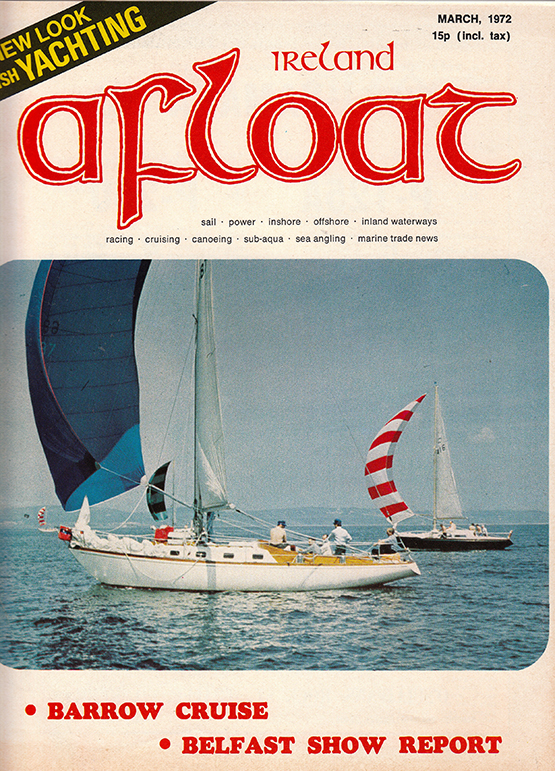
New look Irish Yachting: Afloat's first edition in 1972. Today's magazine and website covers the same Irish maritime topics as it did 43 years ago
At the same time it would make added efforts to reach potential newcomers in every area of boating, and general readers in all other areas of maritime interest. As a result of this, the magazine’s name was then changed to Afloat, and through the 1980s and the 1990s, with occasional changes of publishers, the magazine played a central role in the development and growth of Irish sailing and boating.

Going global. The Feb/March 1992 edition of Afloat celebrated Ireland’s win in both the December 1991 Southern Cross series, and the overall win in the Sydney-Hobart race 1991, with John Storey’s all-conquering Atara as our cover girl...
Since then, as our regular readers will be aware, over the past 20 years Afloat has been on a firm commercial footing and has developed into the comprehensive publication and Internet forum it is today. It continued to be so through the difficult times of recession, and through radical changes both in the Irish marine industry – the main supporters of the published version of Afloat Magazine – and the ways in which those marine manufacturers and traders reach their potential markets.

Another big international win, this time in the 21st century. Ger O’Rourke’s Cookson 50 Chieftain from Kilrush in the early stages of the Rolex Fastnet Race 2007, which she won overall. The Limerick skipper deservedly became Afloat.ie “Sailor of the Year” on the strength of this great achievement. Photo: James Boyd
Consolidation of the global marine industry, combined with the fact that Ireland is now within a very few hours flying time from the main centres of marine manufacturing, have meant that Ireland has become, in effect, a province of the European boat business.
Equally, the growth of the Internet has been such that international marine corporations have been able to develop websites of such quality that they by-pass established means of reaching potential customers. In the final analysis, these website constitute advertising. But they have now reached such a standard of sophistication that the uninformed reader sometimes has difficulty in differentiating a subtle sales pitch from genuine news and comment.
This re-direction of marketing budgets has inevitably impinged on established methods of communication and public conversation in the maritime sphere as elsewhere. But open media outlets such as Afloat.ie have in turn been re-inventing themselves in order to continue to provide their best possible service in an increasingly challenging environment.
In fact, Afloat magazine was one of the first to embrace new technology in the Internet age, with our initial website launched in 1993 with support from Allianz Insurance as Founding Sponsor. Now, some 53 years after Afloat first published on paper, it is the leader in Irish maritime communications online, while at the same time continuing to publish a quarterly version of the magazine on paper, with the Afloat Autumn 2015 edition hitting the news-stands next week.
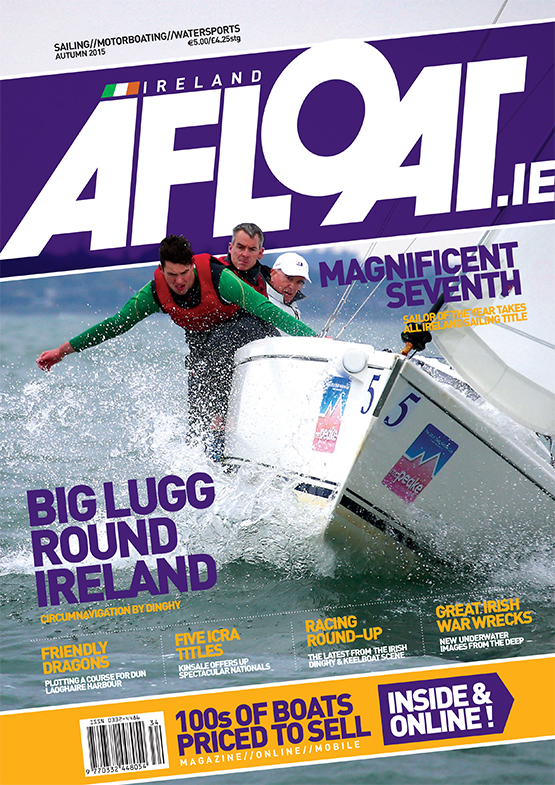
Quarterly form – the up-coming Autumn 2015 Afloat, on sale next week
Today's scenario on the Internet is such that:
Afloat.ie's popular online format has a strong returning readership with around 48% of daily visits being return visitors. In fact over the peak sailing months in 2014 Afloat surpassed its own records for unique (direct) visitors with an average of 52,024 visitors a month, and as this graph shows, our key figures in 2015 are up 12%, with a significant further underlying rise towards the latter part of the season, though nothing quite matches the spike when Musandam Oman was establishing a new Round Ireland Record back in the Spring.

Afloat.ie's improving performance through 2015, with a spike for the successful Round Ireland record bid by Musandam Oman
The team works hard to achieve top Google Search rankings, and together with a tightly bound community of readers, Afloat.ie's continually up-dated combination of opinion, hard news and features puts it at the very heart of the national conversation on sailing, boating and maritime affairs.
It's a satisfying result to date because the aim has always been to provide Irish sailing clubs, classes and the wider maritime community with comprehensive and reliable information in a dynamic independent site to promote our sport to the wider audience which only the Internet provides.
This has been supported this year by the ISA with their renewal of a necessary relationship with Afloat.ie which in a sense marks a return to the situation in 1962. It’s probably a unique tie–up in world sailing, but is necessary because athough Ireland has all the status of a leading sailing nation, globally speaking we have a small national economy.
In addition, the internationalisation of the marine industry, and its increasing reliance on in-house digital communication for product publicity, means that the only significant income stream in Irish sailing and boating is through the clubs and the Sports Council grants which keep the ISA functioning.
The working agreement between the ISA and Afloat allows the association to use Afloat.ie’s sailing news feed and the use of Afloat's Sailor of the Year Award, and it is proving to be a successful link-up. It’s healthy in that Afloat.ie can provide a platform for much livelier discussions and topics than is the case with the ISA’s own website, which is obliged to be somewhat in the nature of a Government Gazette.
The Internet poses many problems, not least for traditional media, but in all my years as a sailing writer I have never seen the potential that exists for exciting Irish sailing communications as clearly as I do today with the current output from the Afloat website. It means that the spirit of the unique and lively Irish sailing and boating community is reflected by their means of communications with each other, and with the outside world.
The ISA has a valuable communications budget that needs to be spent very wisely to cover all areas of our sport, and to achieve this I would urge the ISA and Afloat to seek a stronger relationship. It would be a dynamic move which would help to provide additional communication services to sailing clubs throughout the country, while also reaching out to a wider market, and I am firmly of the opinion that it would fit well with the new direction that the reformed ISA is trying to take.

W M Nixon, seen here at last month’s Cruising Association of Ireland rally in Dublin, became Editor of Irish Yachting when it began commercial monthly publication in 1970. Photo: Aidan Coughlan
Afloat Archive – Reader Relaxes With 43–Year–Old Magazine!
Afloat.ie Facebook 'Likes' Reach 5,000 – Join Us!
#FACEBOOK – Over 5,000 people now 'like' Afloat magazine on Facebook, the social media site. Thanks to all our friends for your comments, suggestions and interest in Irish boating and sailing.
It's a satisfying number to date because the aim has always been to provide Irish sailing and boating clubs, classes and the wider maritime community with comprehensive and reliable information in a dynamic independent site to promote our great sport to the wide audience only the internet provides.
As well as our popular facebook feed the Afloat digital offering includes a healthy twitter feed (4,000 followers) and the independent and award winning Afloat.ie website at its core. We send out a free daily enews to a growing community of over 6,000 boaters. You can subscribe to it HERE and you can check out back issues HERE.
We also have a separate boats for sale website with over 300 different types of boats for sale. The site has a strong returning readership with around 48% of daily visits being return visitors. In fact over the peak sailing months in 2014, Afloat surpassed its own records for unique (direct) visitors with an average of 52,024 unique visitors a month.
We enjoy bringing you timely updates on Irish boating and sailing, clearly readers like them too! We look forward to seeing more and more of you on our Facebook page. 'Like' Afloat HERE and get daily boating updates on your facebook wall.
We work hard to achieve top Google Search rankings and together with a tightly bound community of readers, Afloat.ie's combination of opinion, hard news and features puts it at the very heart of the national conversation on sailing, boating and maritime affairs.
Thanks to all our readers for your continued support!
A New Tall Ship For Ireland? It's Back to The Future
#tallship – The Tall Ships return to Ireland in spectacular style this summer with a major fleet assembly in Belfast from Thursday 2nd to Sunday 5th July for the beginning of the season's Tall Ships Races, organised by Sail Training International. The seagoing programme will have a strong Scandinavian emphasis in 2015, with the route - some of which is racing, other sections at your own speed – starting from Belfast to go on Aalesund in western Norway for 16th to 18th July, thence to Kristiansand (25th to 28th July), which is immediately east of Norway's south point, and then on to conclude at Aalborg in northern Denmark from 1st to 4th August.
But before leaving Northern Ireland with the potentially very spectacular Parade of Sail down Belfast Lough on Sunday July 5th, the celebrations will be mighty. The fleet's visit will be the central part of the Lidl Belfast Titanic Maritime Festival, which will include everything from popular family fun happenings with concerts and fireworks displays – the full works, in other words – right up to high–powered corporate entertainment attractions.
As for the ships, there will be more than enough for any traditional rig and tall ship enthusiast to spend a week drooling over. In all, as many as eighty vessels of all sizes are expected. But more importantly, at least twenty of them will be serious Tall Ships, proper Class A square riggers of at least 40 metres in length, which is double the number which took part in their last visit to Belfast, back in 2009.
That smaller fleet of six years ago seemed decidedly spectacular to most of us at the time. So the vision of a doubling of proper Tall Ship numbers in Belfast Harbour is something we can only begin to imagine. But when you've a fleet which will include Class A ships of the calibre of the new Alexander von Humboldt from Germany, Norway's two beauties Christian Radich and Sorlandet, the much-loved Europa from the Netherlands, George Stage from Denmark, and the extraordinary Shtandart from Russia which is a re-creation of an 18th Century vessel built for Emperor Peter the Great, you're only starting, as that's to name only six vessels – what we'll be seeing will be a truly rare gathering of the crème de la creme.
So although it would be stretching it to think that a small country like Ireland should aspire to having a major full-rigged vessel, we mustn't forget that for 27 glorious years we did have our own much-admired miniature Tall Ship, the gallant 84–ft brigantine Asgard II. Six-and-a-half years years after her loss, it's time and more for her to be replaced. W M Nixon takes a look at what's been going on behind the scenes in the world of sail training in Ireland and finds that, in the end, we may find ourselves with a ship which will look very like a concept first aired for Irish sail training way back in 1954.
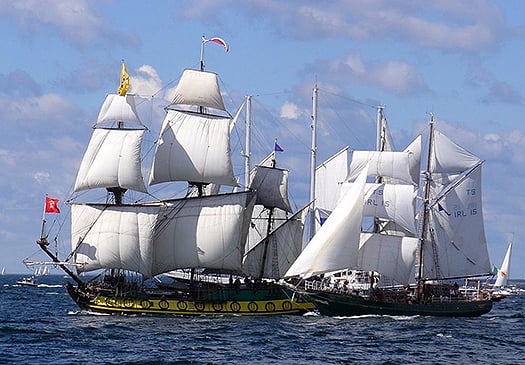
The pain of it. You search out a photo of Shtandart, the remarkable Russian re-creation of an 18th century ship, and you find that Asgard II is sailing beside her
It was while sourcing a photo of Russia's unusual sail training ship Shtandart that the pain of the loss of Asgard II emerged again. It's always there, just below the surface. But it's usually kept in place by the thought that we have to move on, that worse things happened during the grim years of Ireland plunging ever deeper into recession, and that while our beloved ship did indeed sink, no lives were loss and her abandonment was carried out in an exercise of exemplary seamanship.
Yet up came the photo of the Shtandard, and there right beside her was Asgard II, sailing merrily along on what's probably the Baltic, and flying the flag for Ireland with her usual grace and charm. The pain of seeing her doing what she did best really was intense. She is much mourned by everyone who knew her, and particularly those who crewed aboard her. All three of my sons sailed on her as trainees, they all had themselves a great time, and two of them enjoyed it so much they repeated the experience and both became Watch Leaders. It was very gratifying to find afterwards, when you went out into the big wide world and put "Watch Leader Asgard II" on your CV, that it counted for something significant in international seafaring terms.
But as a sailing family with other boat options to fall back on, we didn't feel Asgard II's loss nearly as acutely as those country folk for whom the ship provided the only access to the exciting new world of life on the high seas.

Elaine Byrne vividly recalls how much she appreciated sailing on Asgard II, and how she and her siblings, growing up in the depths of rural Ireland, came to regard the experience of sailing as a trainee on the ship as a "Rite of Passage" through young adulthood
The noted international investigative researcher, academic and journalist Dr Elaine Byrne is from the Carlow/Wicklow border, the oldest of seven children in a farming family where the household income is augmented with a funeral undertaking business attached to a pub in which she still occasionally works. Thus her background is just about as far as it's possible to be from Ireland's limited maritime community. Yet thanks to Asgard II, she was able to take a step into the unknown world of the high seas as a trainee on board, and liked it so much that over the years she spent two months in all aboard Asgard II, graduating through the Watch Leader scheme and sailing in the Tall Ships programmes of races and cruises-in-company
Down in the depths of the country, her new experiences changed the Byrne family's perceptions of seafaring. Elaine Byrne writes:
"Four of my siblings (then) had the opportunity to sail on Asgard II. If it were not for Asgard II, my family would never have had the chance to sail, as we did not live near the sea, nor had the financial resources to do so. The Asgard II played a large role in our family life as it became a Rite of Passage to sail on board her. My two youngest siblings did not sail on the Asgard II because she sank, which they much regret".
She continues: "Apart from the discipline of sailing and the adventure of new experiences and countries, the Asgard brought people of different social class and background together. There are few experiences which can achieve so much during the formative years of young adulthood"
That's it from the heart – and from the heart of the country too, from l'Irlande profonde. So, as the economy starts to pick up again, when you've heard the real meaning of Asgard II expressed so directly then it's time to expect some proper tall ship action for Ireland in the near future. But it's not going to be a simple business. So maybe we should take quick canter through the convoluted story of how Asgard II came into being, in the realization that in its way, creating her successor is proving to be every bit as complex.
As we shall see, the story actually goes back earlier, but we'll begin in 1961 when Erskine Childers's historic 1905-built 51ft ketch Asgard was bought and brought back by the Irish government under some effective public pressure. It was assumed that a vessel of this size – quite a large yacht by the Irish standards of the time – would make an ideal sail training vessel and floating ambassador. It was equally assumed that the Naval Service would be happy to run her. But apart from keen sailing enthusiasts in the Naval Reserve - people like Lt Buddy Thompson and Lt Sean Flood – the Naval Service had enough on its plate with restricted budgets and ageing ships for their primary purpose of fishery patrol.
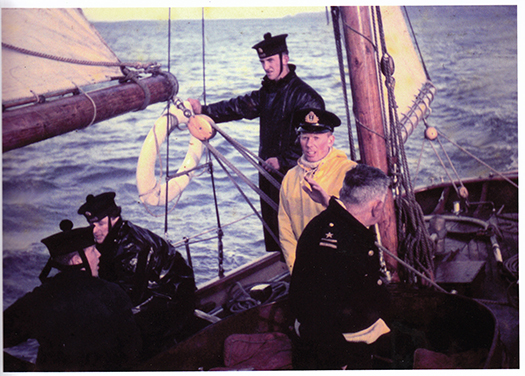
Aboard the first Asgard in 1961 during her brief period in the 1960s as a sail training vessel with the Naval Service – Lt Sean Flood is at the helm
So Asgard was increasingly neglected throughout the 1960s until Charlie Haughey, the new Minister for Finance and the only member of Government with the slightest interest in the sea, was persuaded by the sailing community that Asgard could become a viable sail training ship. In 1968 she was removed from the remit of the Department for Defence into the hands of some rather bewildered officials in the Department for Finance, and a voluntary committee of five experienced sailing people - Coiste an Asgard - was set up to oversee her conversion for sail training use in the boatyard at Malahide, which just happened to be rather less than a million miles from the Minister's constituency.
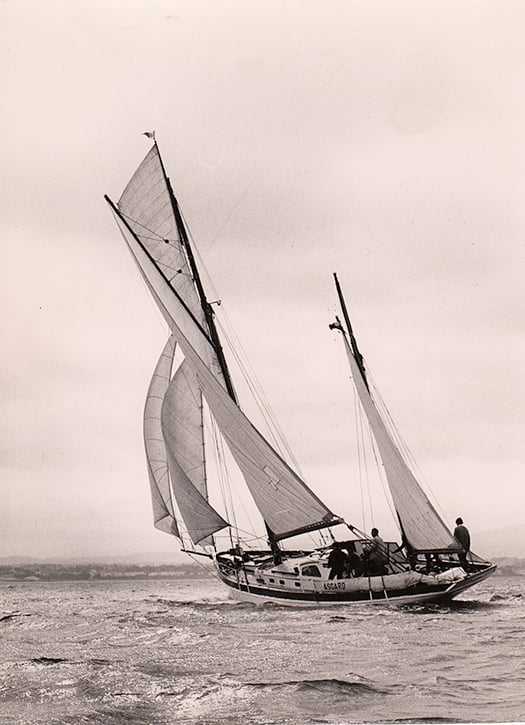
Asgard in her full sail training role in 1970 in Dublin Bay
Asgard was commissioned in her new role in Howth, the scene of her historic gun running in 1914, in the spring of 1969. Under the dedicated command of Captain Eric Healy, the little ship did her very best, but it soon became obvious that her days of active use would be limited by reasons of age, and anyway she was too small to be used for the important sail training vessel roles of providing space to entertain local bigwigs and decision-makers in blazers.
By 1972, the need for a replacement vessel was a matter of growing debate in the sailing community, and during a cruise in West Cork in the summer of 1972, I got talking to Dermot Kennedy of Baltimore out on Cape Clear. Dermot was the man who introduced Glenans to Ireland in 1969, and then he branched out on his own in sail training schools. A man of firm opinions, he reacted with derision to my suggestion that Asgard's replacement should be a modern glassfibre Bermudan ketch, but with enough sails to keep half a dozen trainees busy.
"Nonsense" snorted Dermot. "Ireland needs a real sailing ship, a miniature tall ship maybe, but still a real ship, big enough to carry square rig and have a proper clipper bow and capture the imagination and pride of every Irish person who sets eyes on her. And she should be painted dark green just to show she's the Irish sail training ship, and no doubt about it".
Some time that winter I simply mentioned his suggestions in Afloat magazine, and during the Christmas holidays they were read by Jack Tyrrell at his home in Arklow. During his boyhood, in the school holidays he had sailed with his uncle on the Arklow schooner Lady of Avenel, and it had so shaped his development into the man who was capable of running Ireland's most successful boatyard that he had long dreamed of a modern version of the Lady of Avenel to be Ireland's sail training ship.
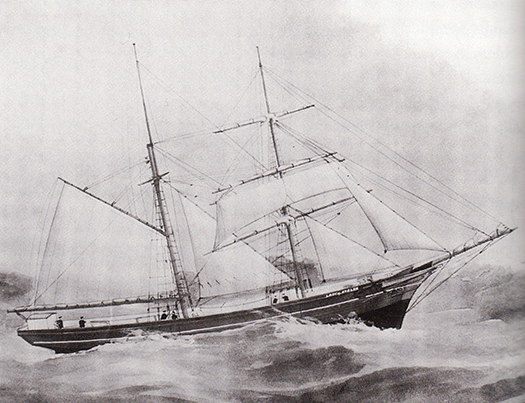
The inspiration – Jack Tyrrell's boyhood experiences aboard Lady of Avenel inspired him to create Ireland's first proper sail training ship
In fact, in 1954 he had sketched out the plans for a 110ft three masted training ship, but Ireland in the 1950s was in the doldrums and the idea got nowhere. Yet the spark was always there, and it was mightily re-kindled by what Dermot Kennedy had said. So at that precise moment, the normal Christmas festivities in the Tyrrell household were over. They'd to continue the celebrations without the head of the family. The great man took himself off down to the little design office in his riverside boatyard, and in clouds of pipe tobacco smoke, he re-drew the lines of the 110ft three master to become an 83ft brigantine, the size reduction meaning that the shop would only need a fulltime crew of five.
Working all hours, he had the proposal drawings finished in time to rejoin his family to see in the New Year. And in the first post after the holiday, we got the drawings at Afloat, and ran them in the February 1973 issue.
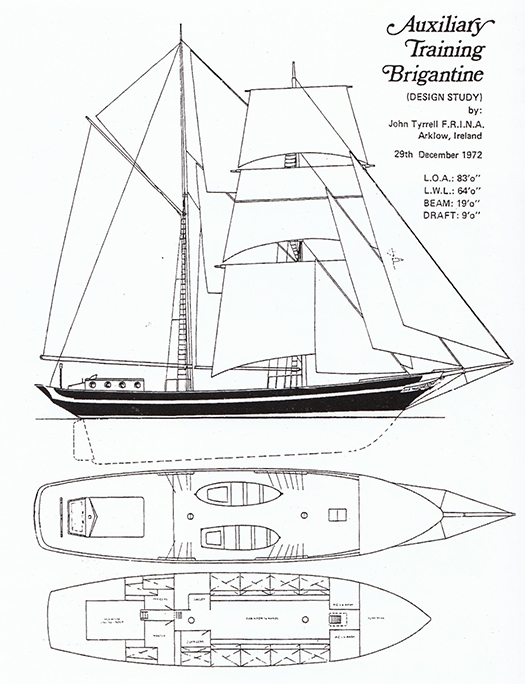
Jack Tyrrell's proposal drawings for the new brigantine, as published in the February 1973 Afloat
In Ireland then as now, most politicians had inscribed in their heads the motto: "There's No Votes In Boats". So after Charlie Haughey had fallen from favour with the Arms Trial of 1970, Coiste an Asgard became an orphan. But 1973 brought a new government, and there was one cabinet minister in it who was proud to proclaim his allegiance to the sea.
Unfortunately for the respectability of the maritime movement in Ireland, our supporters in the higher echelons of politics have often tended to be from the colourful end of the political spectrum, whatever about their placing in the left-right continuum. Thus it was that, at mid-morning on St Patrick's Day 1973, I got an ebullient phone call and an immediate announcement, without the caller saying who he was. "Winkie" he bellowed, "That ship is going to be built. I'll make sure of it. I've just made a ministerial decision".
It emerged that it was our very own new Minister for Defence, Patrick Sarsfield Donegan TD. The enthusiasm for the new ship, engendered by studying Jack Tyrrell's drawings, led to a snap decision which stayed decided, and it all happened in the Department for Defence.
However, it was 1981 by the time the ship was launched, and she looked rather different from Jack Tyrrell's preliminary drawings, though the basic hull shape built in timber was the same sweet lines as originally envisaged, so she was able to sail like a witch. But as for her supporters at Government level, the non-stop cabaret continued. Charlie Haughey had regained power, and by 1981 he was Taoiseach. It was he who had seen to it that the Department of Defence continued to look after the Asgard II project with support from another sailing TD who might not have seen eye–to-eye with him on other matters, Bobby Molloy of Galway.
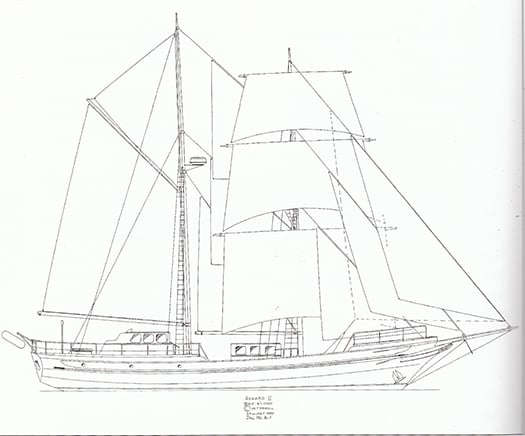
Asgard II in her finished form
So on a March day in 1981, almost exactly twelve years after he'd commissioned the original Asgard in her new role as a sail training vessel, Charlie Haughey took it upon himself to christen the new Asgard II in Arklow basin. And the champagne bottle refused to break. Five or six time he tried, but with no success.
Showing considerable grace under pressure and observed by a large crowd, he quietly took his time undoing all the ribbons and paraphernalia on the big bottle. Then he marched with it up to the new flagship's stem, and hit it a mighty double-handed wallop. The bottle exploded that time, with no mistake. And apart from the usual Haughey growl to those nearby about the idiocy of whoever forgot to score the champagne bottle beforehand, it was all done with the best of humour.
For most of her subsequent career, there's no doubt Asgard was a lucky and very successful vessel. Yet when her demise came, you couldn't help but think of the old notion that if the champagne bottle doesn't break first time, then she'll ultimately be an unlucky ship.
But there are more prosaic explanations. With a limited budget and every penny being scrutinized, Jack Tyrrell and his men had to build Asgard II in fishing boat style, which is fine within its proper time span, but that time span is really only twenty years, maybe thirty if the ship gets extra care. But with her fishing boat hull carrying a demanding brigantine rig, although she always looked immaculate, Asgard II was starting to show her age in the stress areas.
By 2005 there was serious talk about the need to plan for a replacement. When her skipper Colm Newport was told to renew her rig as the original spars were clearly well past it, he meticulously searched the best timber yards at home and abroad and when she got her new rig – it was 2006 or thereabouts – I wrote an only slightly tongue-in-cheek article suggesting that now was the time to replace her old tired wooden hull with a new steel one to the same Jack Tyrrell lines, but utilising the excellent new rig and as many of the fixtures and fittings as were still in good order from the original ship.
To say the response was negative is understating the case. People's attachment to Asgard could only imagine a wooden ship. It was the end of any meaningful debate. So things drifted on, with each new government seemingly even less interested in maritime matters generally, and sail training in particular, than the one before.
In September 2008, Asgard started taking in water while on passage with a crew of trainees towards La Rochelle for a maritime festival following which - while still in La Rochelle – it was planned that she would be lifted out for a thorough three week survey and maintenance programme.

Asgard's accommodation worked superbly whether at sea or in port. But the fact that so much was packed into a relatively small hull meant that some areas were almost inaccessible for proper inspection
It might have been the saving of her. But it was not to be. It's said that it was a failed seacock which caused the catastrophic ingress of water. She was a very crowded little ship, she packed a lot into her 84ft, so some hull fittings were less accessible internally than they would be in a more modern vessel, and may have deteriorated to a dangerous level. But if, as some would propose, she hit something in the water which caused a plank to start, then the fact that nobody aboard was aware of any impact suggests that the time for a major overhaul, and preferably a hull replacement, was long overdue.
The moment Asgard II sank, she ceased to have any future as a sail training vessel, and there was no real official interest in her salvage. You simply cannot take other people's children to sea on a salvaged vessel of doubtful seaworthiness. And as it happens, the sinking came at exactly the time the Irish economy fell of a cliff. So although after an enquiry the Government accepted a €3.8 million insurance settlement, in the end, despite assurances to the contrary, it disappeared into the bottomless pit which was the national debt, and within a year Coiste an Asgard was wound up with its records and few resources incorporated into a new entity, Sail Training Ireland.
The plot takes a further macabre twist in that, shortly after the loss of Asgard II, the Northern Ireland Sailing Training ketch was also lost after hitting a rock on the Antrim coast. From having two popular and well-used sail training vessels in the middle of 2008, within a year Ireland had no official sail training vessels at all.
Yet though the flame had been largely subdued, there were those who have kept the faith, and gradually the sail training movement is being rebuilt. Sail Training Ireland is the frontline representative for around five different organisations, being the official affiliate of Sail Training International, and it has a busy programme of placing trainees in ships which operate at an international level, in which the Dutch are supreme.
In Ireland at the moment, the only sail training "ship" is the schooner Spirit of Oysterhaven, run by Oliver Hart and his team from their adventure centre near Kinsale. In fact, Spirit – you can read about her in Theo Dorgan's evocative book Sailing For Home (Penguin Ireland 2004) – really is punching way above her weight in representing Ireland in a style reminiscent of both the Asgards.
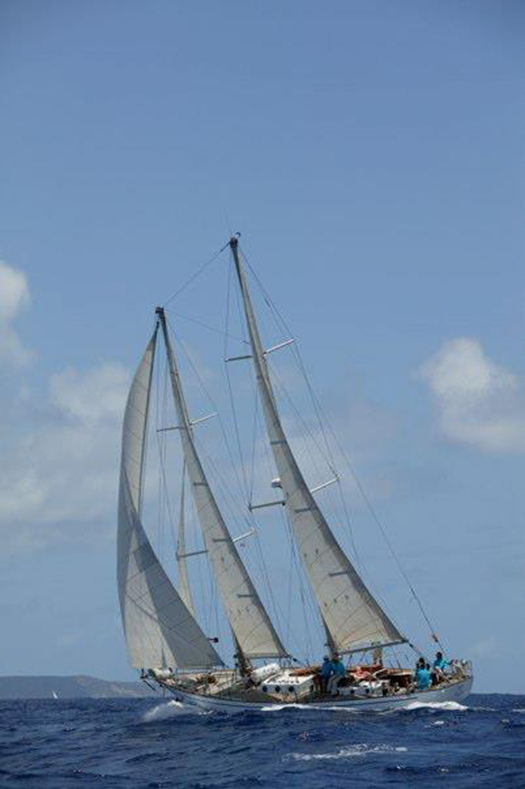
Spirit of Oysterhaven has been doing great work in keeping sail training alive in Ireland
But having the ship is one thing, paying the fees for the trainees to be aboard is something else, and sail training bursaries are one of the key areas of expansion in current maritime development in Ireland. There was an unusual turn to this in 2014 when somebody came up with the bright idea of using Irish Cruising Club funds (which are generated by the surplus from the voluntary production of the club's Sailing Directions) to provide bursaries for youngsters to take part in last summer's ICC 85th Anniversary Cruise-in-Company along the southwestern seaboard on Spirit of Oysterhaven.
The idea worked brilliantly, and this concept of neatly-tailored sail training bursaries is clearly one which can be usefully developed. But still and all, while it's great that young Irish people are being assisted in getting berths aboard charismatic vessels like Europa, the feeling that we should have our own proper sail training ship again is gradually gaining traction, and this is where the Atlantic Youth Trust comes in.
The AYT had its inaugural general meeting in Belfast as recently as the end of September 2014, so it may not yet have come up on your radar. But as it has emerged out of the Pride of Ireland Trust which in turn emerged from the Pride of Galway Trust, you'll have guessed that Enda O'Coineen and John Killeen are much involved, and they've roped in some seriously heavy hitters from both sides of the border, either as Board Members or backers, and sometimes as both.
The cross-border element is central to the concept of building a 40 metre three-masted barquentine, a size which would put her among the glamour girls in Class A, and could carry a decidedly large complement of 40 trainees, even if you're inevitably talking of stratospheric professional crewing costs.
However, by going straight in at top government level on both sides of the border, the AYT team are finding that they're pushing at a door which wants to open, particularly after the new Stormont House agreement was reached in the last days of 2014 to bring a more enthusiastic approach both to cross-community initiatives in the north, and cross border co-operation generally.
Who knows, but if they can succeed in getting cross-community initiatives working in Northern Ireland, then they may even be able to swing some sort of genuine Dublin-Cork shared enthusiasm in the Republic, for I've long thought that one of the factors in holding back many maritime initiatives in Ireland is that, while Dublin may be the political capital, Cork is quietly confident it's the real maritime capital, and does its own thing.
Be that as it may, the AYT have done serious studies, and their conclusion is the best scheme to learn from is the Spirit of Adventure programme in New Zealand. This is where the feeling of going back to the future arises, for in looking at photos of their ship Spirit of New Zealand, there's no escaping the thought that you're looking at Jack Tyrrell's concept ship of 1954 brought superbly to life.
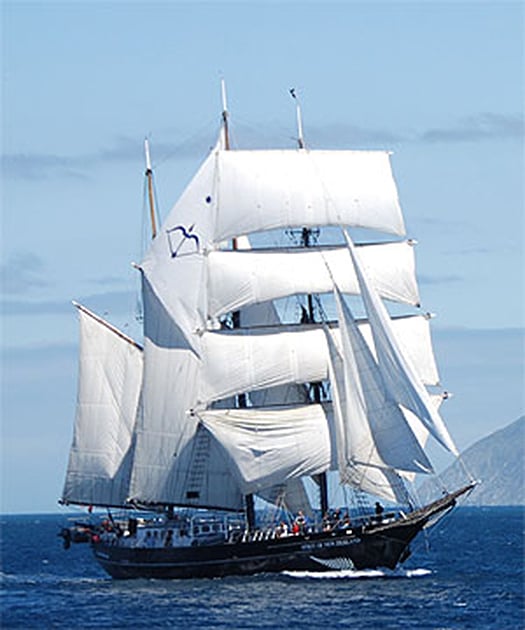
Spirit of New Zealand

Spirit of New Zealand almost seems like a vision of 1954 brought to life...

.....and that vision is Jack Tyrrell's 1954 concept for a 110ft sail training ship
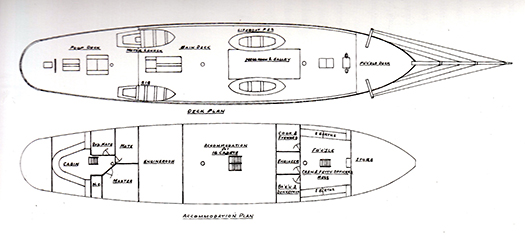
The 1954 accommodation drawings for the 110ft ship hark back to a more rugged age. Imagine the difficulties the ship's cook would face trying to get hot food from his galley on deck amidships all the way back to the officers in their mess down aft
We needn't necessarily agree with all the AYT's basic thinking For instance, they assert that Ireland is like New Zealand is being an isolated smallish island. It depends what you mean by "isolated". Those early sail training pioneers, the Vikings, certainly didn't think of Ireland as isolated. They thought it was central to the entire business of sailing up and down Europe's coastline.
Thus any all-Ireland sail training vessel would be expected to be away abroad at least as much as she'd be at home, whereas Spirit of New Zealand is usually home – the season of 2013-2014 was the first time she'd been to Australia since 1988, when she was in the fleet with Asgard II for the First Feet celebrations.
In New Zealand, she's a sort of floating adventure centre, and a large tender often accompanies her to take the trainees to the nearest landing place for shoreside adventures, for it's quite a challenge keeping 40 energetic young people fully occupied.
In Europe, that's where the sail training races come in. Time was when the racing aspect was down-played. But there's nothing like a good race to bring a mutinous crew together, and the recently-published mega-book about the world's sail training vessels, Tall Ships Today by Nigel Rowe of Sail Training International, quite rightly devotes significant space to everything to do with the racing.
Thus if we do get a new sail training ship for Ireland, she'll have to sail well and fast. That was Asgard II's greatest virtue. For there is nothing more dispiriting for troubled young folk than to find themselves shackled to the woofer of the fleet. Yet you'd be pleasantly surprised by how previously disengaged youngster can become actively and enthusiastically involved when they find that they're being transformed from scared and seasick kids into members of a winning crew.
So now, the 64 thousand dollar question. The cost. It's rather more than 64 thousand. AYT reckon they'll have to come up with a final capital expenditure of €15 million to build the ship and get her into full commission with proper crewing and shoreside administration arrangements in place. But after that – and here's the kernel of the whole concept – they reckon that the running costs will come out of existing government expenditure already in place and used every year for education, youth training, sporting facilities, social development and so forth.
So their pitch is that if the governments north and south come up with funding to support substantial donations already proposed for AYT by various benevolent national and international bodies, then once the ship is in being, she will generate her own income in the same way as vessels like Europa and Morgen Stern are already doing in mainland Europe.
And it's to the heart of mainland Europe that they'll be looking for design and contruction, as it's the Dykstra partnership which will be overseeing the design, and their ship-build associate company Damen will likely do the construction work, though one idea being floated is that Damen might provide a flatpack kit for the vessel to be built in steel in Ireland.
Those of us who dream of Asgard II being built anew will find all this a bit challenging to take on board. My own hopes, for instance, would still be to build Asgard II again to Jack Tyrrell's lines, but with the hull constructed in aluminium. It would be expensive as it would need to be double-skin below the waterline, but the ship's size would be very manageable with a professional crew of just five, while she'd sail like a dream And proper top-class marine grade aluminium seems to last for ever, as naval architect Gerry Dijkstra (his surname is slightly different from that of the partnership) himself shows with his remarkable cruises with his own-designed alloy 54-footer Bestevaer.
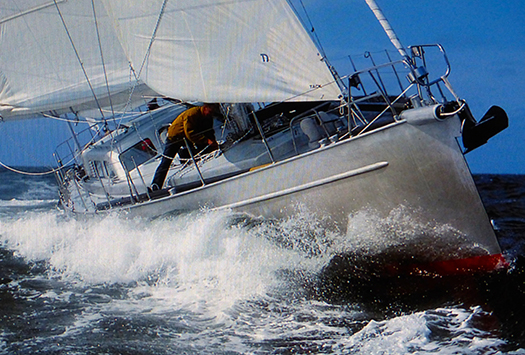
A man who knows what he's doing. This is Gerry Dijkstra's own extensively-cruised alloy-built 54 footer Bestevaer. The name translates not as "Best ever", but either as "best father" or "best seafarer", and was the name of affection given to the great Admiral de Ruyter by his loyal crews
Whatever, the good news is that things are on the move, and we wish them well, all those who have kept the Irish sail training flame alive through some appalling setbacks. Now, it really is the time to move forward. And if we do get a new ship, why not call her the Jack Tyrrell? He, of all people, was the one who kept the faith and the flame alive.
- Tall ship
- Belfast
- Jack Tyrell
- Kristiansand
- Aalesund
- Titanic
- maritime
- Class A
- square riggers
- George Stage
- Alexander Von Humboldt
- Christian Radich
- Sorlandet
- Shtandart
- Brigantine
- Asgard II
- Elaine Byrne
- Erskine Childers
- Sean Flood
- Naval
- Afloat magazine
- boatyard
- sail training ship
- Coiste an Asgard
- Charlie Haughey
- Colm Newport
- Irish Cruising Club
- Spirit of Oysterhaven
- Enda O'Coineen
- John Killeen
- Dykstra
Afloat Magazine Autumn Issue In Shops Now!
#Afloatmagazine – With all the latest sailing, boating and maritime news and views from coast to coast, Afloat's Autumn issues hit the shelves at the weekend.
Editorial
The 'blue economy' – there has been a maritime awakening, can Ireland expect its own Marine Department sometime soon?
News
Cork, the global yacht racing hub, RCYC ready for Dinghy Week 2015, Spanish Armada on a Sligo beach, Volvo appoint MGM, Dromineer lifeboat plans, dead cow hazards and Naval Reserves pass out plus much, much more
with another 50 maritime news stories
Island Nation
The Minister for Finance acknowledged our Island status in the recent budget
Shannon Blueway launched
The Shannon Blueway runs from Drumshanbo through Battlebridge and Leitrim Village to Carrick–on–Shannon
ISAF Youth Worlds success
A week in which Ireland's Seafra Guilfoyle topped the leaderboard and took silver in the last race
Olympics 2016 – Three for Rio
Providence Team Ireland set out to achieve three nation places at September's ISAF Worlds in Santander and did just that!
Justin Slattery – Volvo Racer
Marcus Hutchinson interviews Ireland's Volvo Ocean Race bowman from Abu Dhabi Ocean Racing
Optimist Europeans Dun Laoghaire
The Royal St. George Yacht Club produced a stand–out regatta for 254 young sailors from
43 nations in July.
ISA Junior Helmsmans
Young Harry Durcan from the Optimist class topped the fleet of junior champions in Kinsale to win Ireland's
top youth prize
City One designs in Limerick
The Minister for Finance Michael Noonan launched the boats built in the visionary CityOne project in the Shannonside city
Racing round–up
Six pages of racing news from a busy dinghy and keelboat scene
Inland
Brian Goggin on the need for fresh ideas on the inland rivers and lakes
Brokerage
The latest boats and equipment in Ireland's marine marketplace
Classifieds
A selection of Afloat.ie's online classified adverts
Dubarry Nautical Crossword
A nautical crossword with a great boating prize of Dubarry deck shoes
Soundings
Mark rounding....it's the very essence of racing, you know!
Afloat Magazine Summer Issue – Out Now!
#Afloatmag – A packed 64–page Summer edition of Afloat hits the newsstand this week, full of all the top Irish boating stories. Here's some of the highlights:
Editorial
If there has been a maritime awakening, can Ireland expect its own Tall Ship sometime
soon?
News
Fastest dinghy in the world, Navy's third order, RCYC ready for Cork week, Ainslie' Auld mug, small craft register blocked, Baltimore is keen, smartphone radio's a lifesaver and Yamaha's new 115 outboard plus much, much more with another 50 maritime news stories
What's in a name?
How do you feel about being called an islander?
Dun Laoghaire's harbour of opportunity
Harbour CEO Gerry Dunne responds to Afloat's article on Ireland's biggest boating centre
ISA new direction
New president David Lovegrove maps out plans for a new course for sailing's national governing body
Voila, a new Jeanneau
The latest in sailing technology from Jeanneau has arrived in Ireland. It's the Sun Odyssey 379
Company profile – Yachtsman
Boating has always been a passion for Yachtsman/Euromarine marine insurance specialists who are celebrating 40 years in business
Ocean goer
A new €230,000 family sailing cruiser arrived
in Greystones. Beneteau's Oceanis 48 has
some new features including a transom trick
ICRA Champs 2014
Dun Laoghaire's waterfront came alive for June's 115–boat regatta. Five new champions were crowned at the Royal Irish Yacht Club and there was wind...in the end
Success on the Solent
Anthony O'Leary's Antix crew from Cork won the British IRC Champs in style
Sailing the north and east coasts
What the east coast lacks in glamour it makes up for in other ways, writes WM Nixon
Racing round –up
Six pages of racing news from a busy dinghy and keelboat scene
Inland
Brian Goggin takes a break on the British canals
Brokerage
The latest boats and equipment in Ireland's marine marketplace
Classifieds
A selection of Afloat.ie's online classified adverts
Dubarry Nautical Crossword
A nautical crossword with a great boating prize
Soundings
With Sally O'Keeffe it's love at first sight. WM Nixon on the sweetest thing in the west.
#afloatmag – Afloat's packed 64–page 2014 Spring issue hits the news stands next week (Monday, 24 March) with all the latest Irish sailing news and views.
In our latest news section, there's been a top prize for David Kenefick, and Kinsale Yacht Club too. Pilot boats are tested in the roughest seas off Cork harbour. We ask if sailing needs to chart a new course outside of the Olympics?
Also in news: Rio waters a sewer, boat reg rules imminent, Marine finance returns, Naomh Éanna's refuge, Kinsale honours Mellett, Transat for Ireland?
There's a big summer in prospect for Greystones marina plus 50 more Irish boating stories!
In features Dun Laoghaire's waterfront area and harbour is a hotbed of development and proposed projects but WM Nixon asks if the east coast port has lost the plot? W M Nixon confirms Irish hearts are still in wooden boats and with the recent lift in the economy is this the right time to bag a boating bargain?
Our cover story tells how a young Irish rookie sailor lifted Afloat's top prize. Solo sailor David Kenefick's fabulous debut season is reviewed.
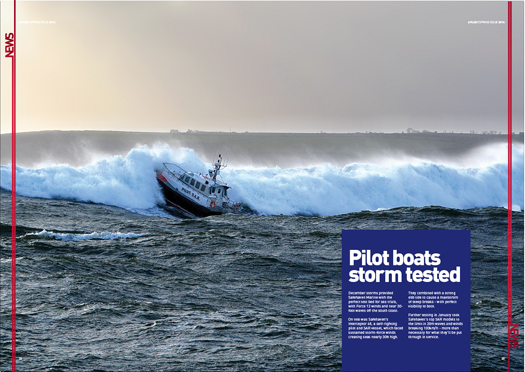
Rough times – Pilot boats storm tested Safehaven boats face the biggest winter waves off Cork Harbour
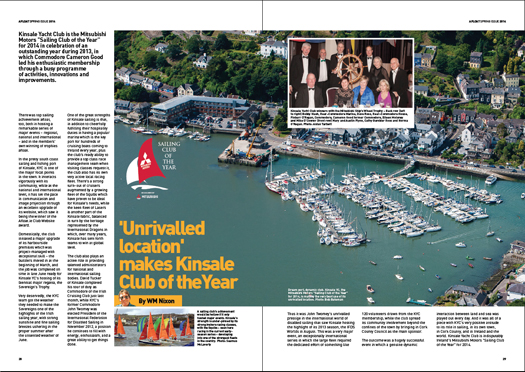
Club of the Year – Kinsale Yacht Club is the Mitsubishi Motors "Sailing Club of the Year" for 2014 in celebration of an outstanding year in 2013

Keep on Cruisin' – John Leahy of the Cruising Association gives an overview of 2014's activities

Stopping the decline – Tom MacSweeney speaks with cruiser racing's Denis Kiely on what can be done to support sailing
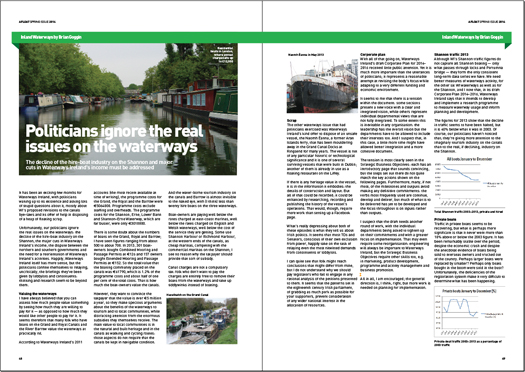
Inland – Politicians ignore the real issues on the waterways, says Brian Goggin
Plus all our regular departments full of Irish sailing and boating news
The Irish heart is still in wooden boats
W M Nixon takes a look at some current Irish wooden boat-building projects.
Owning your dreamboat
W M Nixon suggests that now may be the best time to buy.
Classifieds
A selection of Afloat.ie's classified adverts
Dubarry Nautical Crossword
A nautical crossword with a great
boating prize
Soundings
Sean Walsh of Dun Laoghaire is the new
President of the Old Gaffers' Association




























